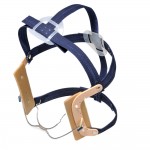
Moving the upper molars backwards during orthodontic treatment is sometimes necessary. Appliances used for this are categorized in to intraoral or extraoral appliances. External headgear is one of the commonest distalising approaches. The aim of this Cochrane review was to assess the effects of orthodontic treatment for distalising upper first molars in children and adolescents.
The Cochrane Oral Health Group’s Trials Register, the Cochrane Central Register of Controlled Trials (CENTRAL), Medline and Embase databases were searched along with clinical trials.gov, The IFMPA clinical trials portal and Current Controlled Trials. Handsearching of bibliographies and orthodontic journals that had not already been searched as part of the Cochrane Oral Health Group’s journal handsearching programme was also carried out. Randomised clinical trials involving the use of removable or fixed orthodontic appliances intended to distalise upper first molars in children and adolescents were included and the usual Cochrane methodological approached were followed.
- 10 studies (354 patients) were included in this review. Study quality was generally poor, the majority (7) were considered to beat high risk of bias, the remaining 3 were at unclear risk.
- Distalising appliance compared to an untreated control (4 studies 159 patients)
- Meta-analyses were not undertaken for all primary outcomes due to incomplete reporting of all summary statistics, expected outcomes, and differences between the types of appliances. The degree and direction of molar movement and loss of anterior anchorage varied with the type of appliance.
- Distalising appliance versus headgear (4 studies 150 patients)
- The mean molar movement for intraoral distalising appliances was -2.20 mm and – 1.04 mm for headgear.
- There was a statistically significant difference in mean distal molar movement (mean difference (MD) -1.45 mm; 95% confidence interval (CI) -2.74 to -0.15) favouring intraoral appliances compared to headgear.
- However, a statistically significant difference in mean mesial upper incisor movement (MD 1.82 mm; 95% CI 1.39 to 2.24) and overjet (fixed-effect: MD 1.64 mm; 95% CI 1.26 to 2.02; two studies, unclear risk of bias, 70 participants analysed) favoured headgear, i.e. there was less loss of anterior anchorage with headgear.
- Direct comparisons of intraoral appliances were reported narratively due to the variation in interventions. All appliances were reported to provide some degree of distal movement, and loss of anterior anchorage varied with the type of appliance.
- No included studies reported on the incidence of adverse effects (harm, injury), number of attendances or rate of non-compliance.
The authors concluded
It is suggested that intraoral appliances are more effective than headgear in distalising upper first molars. However, this effect is counteracted by loss of anterior anchorage, which was not found to occur with headgear when compared with intraoral distalising appliance in a small number of studies. The number of trials assessing the effects of orthodontic treatment for distilisation is low, and the current evidence is of low or very low quality.
Links
Jambi S, Thiruvenkatachari B, O’Brien KD, Walsh T. Orthodontic treatment for distalising upper first molars in children and adolescents. Cochrane Database of Systematic Reviews 2013, Issue 10. Art. No.: CD008375. DOI: 10.1002/14651858.CD008375.pub2.
